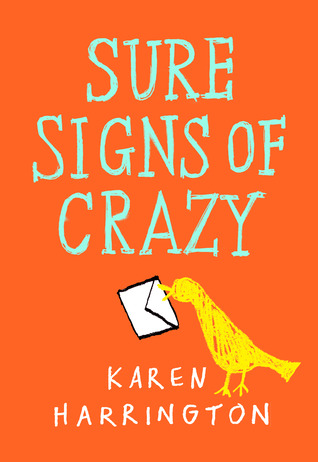
The Ink Splat is our monthly activity letter filled with inspiration sparking challenges and resources guaranteed to inspire your creativity. In this Ink Splat, the book and author spotlighted is Sure Signs of Crazy by Karen Harrington along with an author interview!
The Challenge: Letters to Characters
In Sure Signs of Crazy, part of the story-line involves a teacher requesting that his students practice their writing skills by writing to a favorite character in a book. What would you tell your favorite character? What questions would you ask?
Submit your letter here for a chance to be published online! What are you waiting for?
 Sure Signs of Crazy by Karen Harrington
Sure Signs of Crazy by Karen Harrington
You’ve never met anyone exactly like twelve-year-old Sarah Nelson. While her friends obsess over Harry Potter, she spends her time writing letters to Atticus Finch. She collects trouble words in her diary. Her best friend is a plant. And she’s never known her mother, who left when Sarah was two.
Everything changes when Sarah launches an investigation into her family’s Big Secret. She makes unexpected new friends and has her first real crush, and instead of a “typical boring Sarah Nelson summer,” this one might just turn out to be extraordinary.Since then, Sarah and her dad have moved from one small Texas town to another, and not one has felt like home.
 An interview with author, Karen Harrington!
An interview with author, Karen Harrington!
1. In Inklings classes we play theater games to explore our characters. While you were writing, did you ever feel as if you were one of the characters?
feel as if I was a character, but I think I saw the world through Sarah’s eyes. I think that’s a fun and necessary part of the writing process. For Sarah, I began to see the importance of Atticus Finch through her young eyes and so I shared her desire to have him as a father. If I’d discovered TO KILL A MOCKINGBIRD at her age, I might have written letters to Atticus, too.
2. How did you come up with the title, Sure Signs of Crazy?
The publisher came up with this title. My original title was NO ORDINARY GIRL, but SURE SIGNS is much better. It connects to Sarah’s longing to understand if she will inherit the traits of her mother. She’s on a quest to look for the signs.
3. What books have influenced your life most?
There are so many. Certainly TO KILL A MOCKINGBIRD had a huge impact on me as a person and as a writer. When I first read it, I wanted Atticus Finch to be my father. When I became a mother, I wanted to parent like Atticus Finch.
Other books I’ve loved and reread are LITTLE WOMEN by Louisa May Alcott and THE WITCHES OF BLACKBIRD POND by Elizabeth George Spear. These are two books I can say were in my “I can’t put this down/I don’t want to go to dinner” books. Later, I came to love Ernest Hemingway, Tim O’Brien, Pat Conroy and Elizabeth Berg. And in recent years, I’ve become a huge fan-girl of Jerry Spinelli, Gary D. Schmidt and Rebecca Stead.
4. The blank page can be scary and intimidating. When you first get a new idea for a story, what is your process for beginning?
For all my first drafts, I pretend I’m telling the story to my best friend. This takes a lot of the pressure off to have a perfect draft. For example, when you are “telling” a story, sometimes you zigzag backwards and say to your friend, “Oh, I forgot to tell this part…” Or, sometimes your friend might interrupt you and ask a question in the middle of your “telling” and so you pause and answer that question. For your first draft, there are no rules and you can zigzag and have all the interruptions you want.
5. What advice do you have for aspiring young writers?
Read! Reading inspires writing. So many of history’s great writers didn’t attend a fancy writing school. They went to the library. If you are stuck in your writing, go read. There’s something about reading a good story that makes you want to go write one. For me, when I feel that my writing well is running dry, I spend a couple of hours reading and before long, I want to open my notebook and write. For a writer, reading great sentences is the same as an athlete doing stretches before a run or a game. Think of it: athletes don’t just show up to the track and BOOM, sprint to the finish. You see them on the sidelines doing all kinds of stretches and preparation techniques. You have to do this as a writer. You have to give yourself a warm up period. (Actual stretching is also very, very wise, too.)
And when you DO read, read like a writer. Take note of why you loved a certain scene or sentence. Really be alert to how a book is moving YOU. Take note of why something made you cry or laugh. How the author made you scared or eager to turn the next page.
The other piece of advice is not to give up. Surely, other people have said this more profoundly, but it’s because it’s true. I have a nice, fat file of rejection letters. I have more than twenty stories that have only been seen by the inside of my drawer. But all of that writing was important. It was experience. No writing is ever wasted. None of it. It’s all part of the education. Every bit of it is useful and necessary. Every bit!
Thank you, Karen Harrington!


